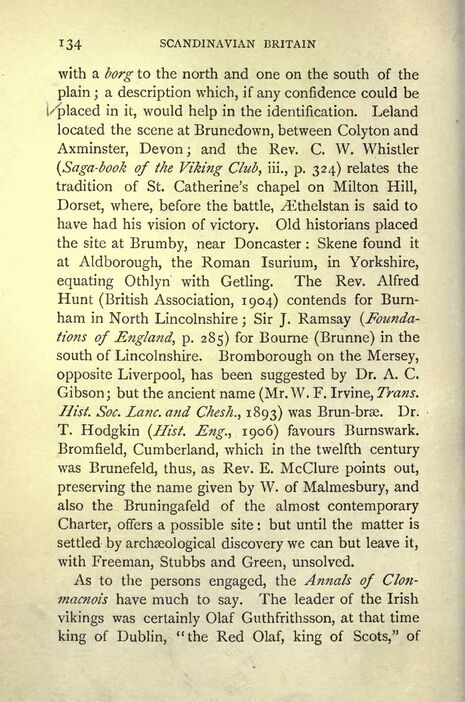
Full resolution (JPEG) - On this page / på denna sida - Scandinavian Britain - II. The Danelaw - 4. The Kingdom of York

<< prev. page << föreg. sida << >> nästa sida >> next page >>
Below is the raw OCR text
from the above scanned image.
Do you see an error? Proofread the page now!
Här nedan syns maskintolkade texten från faksimilbilden ovan.
Ser du något fel? Korrekturläs sidan nu!
This page has been proofread at least once.
(diff)
(history)
Denna sida har korrekturlästs minst en gång.
(skillnad)
(historik)
with a borg to the north and one on the south of the
plain ; a description which, if any confidence could be
placed in it, would help in the identification. Leland
located the scene at Brunedown, between Colyton and
Axminster, Devon; and the Rev. C. W. Whistler
(Saga-book of the Viking Club, iii., p. 324) relates the
tradition of St. Catherine’s chapel on Milton Hill,
Dorset, where, before the battle, Æthelstan is said to
have had his vision of victory. Old historians placed
the site at Brumby, near Doncaster : Skene found it
at Aldborough, the Roman Isurium, in Yorkshire,
equating Othlyn with Getling. The Rev. Alfred
Hunt (British Association, 1904) contends for Burnham
in North Lincolnshire ; Sir J. Ramsay (Foundations
of England, p. 285) for Bourne (Brunne) in the
south of Lincolnshire. Bromborough on the Mersey,
opposite Liverpool, has been suggested by Dr. A. C.
Gibson; but the ancient name (Mr. W. F. Irvine, Trans.
Hist. Soc. Lane, and Chesh., 1893) was Brun-bræ. Dr.
T. Hodgkin (Hist. Eng., 1906) favours Burnswark.
Bromfield, Cumberland, which in the twelfth century
was Brunefeld, thus, as Rev. E. McClure points out,
preserving the name given by W. of Malmesbury, and
also the Bruningafeld of the almost contemporary
Charter, offers a possible site : but until the matter is
settled by archæological discovery we can but leave it,
with Freeman, Stubbs and Green, unsolved.
As to the persons engaged, the Annals of Clonmacnois
have much to say. The leader of the Irish
vikings was certainly Olaf Guthfrithsson, at that time
king of Dublin, "the Red Olaf, king of Scots," of
<< prev. page << föreg. sida << >> nästa sida >> next page >>